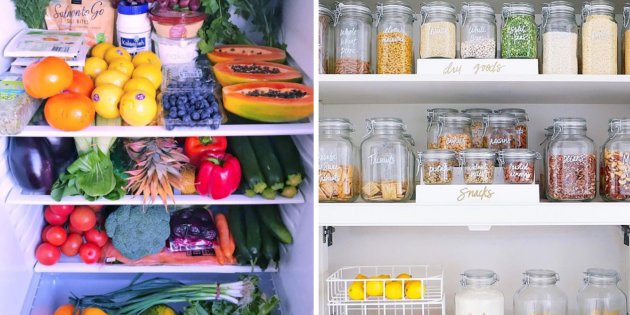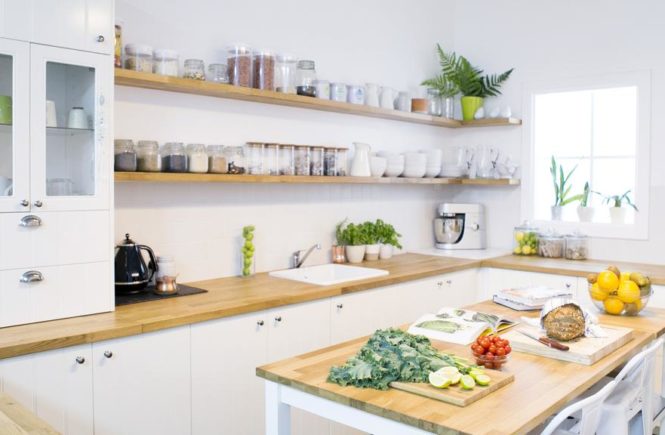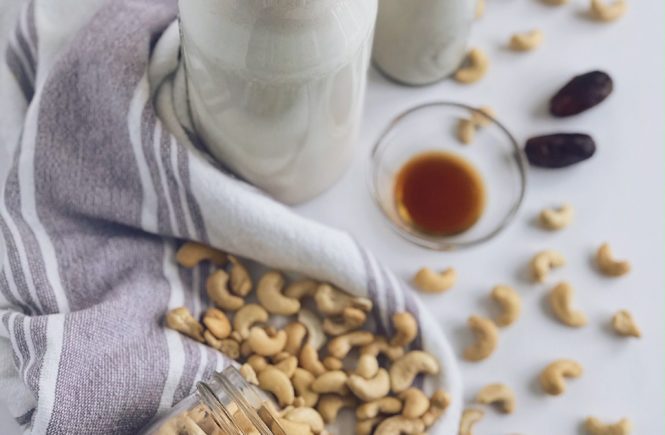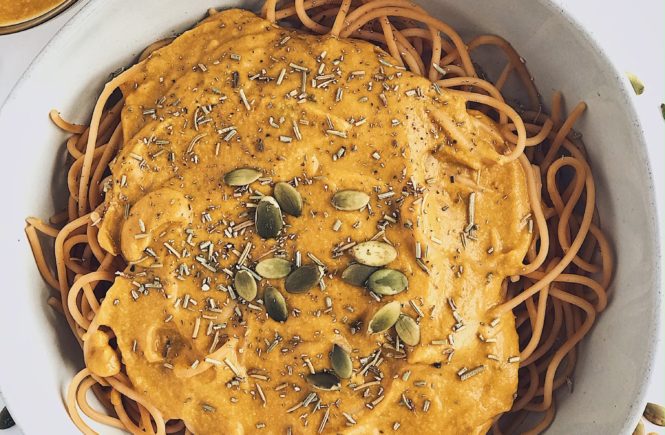Ah, the kitchen. The heart of the home. It’s where the party’s at. It’s the place where everyone comes together. That one room we always seem to circle back to eventually. Well, that and the bathroom. But let’s not go there.
The house I grew up in was totally and completely centered around the kitchen. Aside from my dad’s shed and driveway (he’s a mechanic) the kitchen was where it all went down.
Albeit, my house was a revolving door of people, often at max capacity, and the back door led into the kitchen. My dad got mad when we used the front door. Getting off topic.
Depending on your day to day habits and lifestyle, the kitchen can either be a healthy and vibrant source of nourishment and culinary inspiration, or an intimidating place that is filled with toxic temptation.
Coming from someone who used to dislike the idea of cooking anything and just wanted what was fast and easy (and whatever had the least calories), I’m here to tell you that you do not have to become a gourmet chef or a fancy superfood wizard to start utilizing your kitchen in a healthier way. Cooking fresh, delicious meals for you and your family can be simple, healthy, and even fun!

So let’s say you’re ready to jump on the bandwagon and start getting healthy. (New Year’s Resolution, anyone?)
Perhaps you want to start cooking more of your meals rather than eating out. Or maybe you’re looking to transition to a more plant-based diet. Or maybe you just want to limit the amount of processed foods you eat. Whatever the case may be, it’s great and I applaud you!
But maneuvering the culinary world can get tricky, especially with our holistic health and wellness concepts in mind. And it goes way beyond the actual food we’re consuming.
What about the vessels we’re cooking in, our organization system, our budget, how we prepare our food, the WAY we eat our food, our intentions in the kitchen, our mindset? Throw in a tight budget and all of this can get overwhelming pretty quickly, especially to a non-toxic kitchen novice!
That is why I’m sharing my top 10 tips for a healthier kitchen, to pave the way so you can get cookin’!
1.) Follow the EWG's Dirty Dozen and Clean 15 produce lists.
Choosing organic whenever we can to eliminate toxic pesticide residues from our fruits and veggies is of the utmost importance. But as we know, this can unfortunately get quite expensive due to the higher cost of organic vs. conventional.
My tip is to follow the EWG‘s dirty dozen and clean 15 lists, which provides you with a literal guide to which items contain the highest pesticide levels and which have the least. This way, you can make healthy and informed, yet still budget-friendly decisions on which items to purchase organic and which ones are safe to buy conventional. This will save you money while still keeping your kitchen a non-toxic haven. Just make sure to thoroughly wash any inorganic produce.
2.) Shop sales (and discount warehouses) and stock up.
That moment when the organic blueberries go on sale for $1.99. *buys them all* Certain items like berries, bananas, grains, flours, beans, etc. are easy to stock up on because they either last a while in your pantry or are freezer-friendly. If I find a particularly good deal, I stock up on it.
Warehouses like Costco are helpful here, too. I get a 2 lb jar of cashews there that I store in the freezer, a big bag of quinoa for the pantry, a bag of greens and bunches of bananas that I freeze for smoothies, etc., all at a fraction of the price of regular grocery stores.
Warehouses are great for stocking up on frozen goods too, which can save you money. I always keep bags of frozen veggies and smoothie ingredients in my freezer to have on hand.
3.) Invest in multi-purpose kitchen tools.
The most expensive countertop appliance in my kitchen is my Vitamix, but it is also the most useful. It truly does it all and can take the place other appliances like stand mixers, food processors, cheese graters, and I’ve even been using it to make my morning celery juice– sans juicer! I also use it to make easy homemade nut milk.
For someone like me who loves to cook and bake (and makes at least one smoothie and juice a day), the investment in this machine is well worth it. It can help make cooking more enjoyable and makes it easy to whip up healthy creations, which will inspire you to experiment and cook more.
Look into appliances like this that can serve more than one purpose. If you know you will use it daily, then it is probably worth the investment, especially for a high quality item that will last forever.
Yet another reason to check out Costco: I got my Vitamix there for the lowest price I’ve ever seen. Costco carries tons of other useful discounted appliances as well. Vitamix also offers refurbished models at lower prices.
4.) Also invest in a good water filter.
Clean, pure drinking water is essential to our health and well-being. But think about all the other instances in which we need to use water in the kitchen. Most city water is heavily contaminated with toxins like fluoride, chlorine, heavy metals, even pharmaceuticals. No thank you!!
Whole-home water purification systems can get super pricey. An effective and cheap route is to drop charcoal sticks into pitchers of water. But to really eliminate all of the toxins in your water, you’ll have to invest in a slightly more “sophisticated” system.
We have a Berkey purifier which we love. Our water tastes great and the system is super convenient. Berkey uses a simple gravity filtration system like pitchers do, but their patented Black filter removes over 99% of contaminants. The convenience of it helps us to drink more water throughout the day. There is no plumbing or electricity involved so its a fantastic emergency water source as well!
5.) Use non-toxic cookware.
If you haven’t replaced your cookware in a number of years, you may want to investigate further into what it is you’re actually cooking your food in. That chipped and peeling hand-me-down teflon frying pan your parents have had since the 90’s? Probably needs to be replaced.
Toxins in our cookware like PTFE (Teflon), PFOA, copper, nickel, lead, BPA, and so on, can seep into our food as it heats up. The best non-toxic options are ceramic, cast iron, stainless steel, and glass. Be wary of plastic cooking utensils like spoons and spatulas as well!
6.) Limit the amount of plastic used in your kitchen (and in your life in general).
Today, it’s nearly impossible to go a day without coming into contact with something made out of plastic. This is somewhat of a tragedy considering how detrimental plastic can be to the environment, and not to mention our health.
BPA is an endocrine disruptor found in many plastics that can leech into our food and beverages. Aluminum cans are often lined with BPA as well, so it’s best to avoid canned foods or purchase BPA-free cans/cartons instead. Even plastic labeled BPA-free still contains toxins, so it is not ideal for food storage (especially hot food).
The solution? Glass. Pyrex and Snap-ware make glass containers (again, Costco). A more cost-effective replacement for your old plastic containers are mason jars. You can also utilize mason jars as glasses for beverages, and to store things in your pantry like dry grains and beans, gluten-free flours, nuts and seeds, healthy pasta, etc. Which leads us to my next tip…
7.) Keep your fridge and pantry stocked with healthy, whole food options.
This one is kind of a no-brainer. The more healthy options you have on hand, the less likely you will be to reach for processed food.
I like to keep my fridge stocked with plenty of fruit and raw veggies to snack on like apples, bananas, baby carrots, celery, cucumber, jicama sticks, grape tomatoes, berries, and melon in the Summer. The high fiber content of raw fruits and veggies is so important for keeping us satiated and most people just don’t get enough in a day.
Most of these foods are easily portable too, so you can pack them away in your gym bag for post-workout snacks or bring them to work.
8.) Create an organization system that helps to keep you on target with your wellness goals.
You can buy tons of produce, plan your meals, and have the best intentions in the world to eat more healthfully, but if it’s not as convenient as possible, we will be less likely to reach for it, as opposed to the box of crackers sitting right there on the counter. Do yourself a favor and organize your pantry and/or fridge in a way that makes the healthiest foods the most accessible.
Keep a bowl of fruit out instead of a jar of cookies. Pull the jars of healthy whole grains to the front of the pantry instead of the canned soups. Make it easy to see and access the vegetables in the crisper drawer. Use clear containers so you can see everything you have.
9.) Use all natural and non-toxic cleaning products.
This goes for your entire home, but is particularly important in the kitchen. I don’t know about you, but I feel like I clean my countertop a hundred times a day. All of our food is prepared here, so we definitely don’t want to throw any harsh chemicals into the mix!
Brands like Seventh Generation and Greenshield make effective and affordable all-natural cleaning supplies. A super budget-friendly option is to make your own cleaning products. I make my own multi-purpose cleaning spray out of vinegar and water.
All-Natural Countertop Cleaner: Mix 1 cup white vinegar and 1 cup water. Add 3 drops of tea tree oil and 3 drops of grapefruit, lemon, or orange oil (optional). Pour into a spray bottle and shake well before each use!
10.) Infuse your meals with love and good vibrations.
Have you ever wondered why meals cooked for us by loved ones are so delicious and nourishing? Okay, maybe your mom is an awesome cook and that’s part of it, but it’s also because your food was made with love!
It might sound woo-woo, but the energy we put forth into the universe while cooking has an effect on the vibrational quality of our meals.
In Ayurveda, it is not advised to eat leftovers that are older than a few days. Food that is not fresh is said to accumulate Tamas, a stagnant, low vibrational quality. Ideally, our food is as fresh and healthy as possible to promote a Sattvic, or pure, high vibrational diet.
This is one of the reasons I am personally not a fan of “meal prep” or preparing food more than a day in advance. However I do find it is helpful to wash and prep produce ahead of time so that it is ready to be cooked later. As always, do what works best for you!
How do YOU keep things healthy in your kitchen? I want to know your thoughts!



